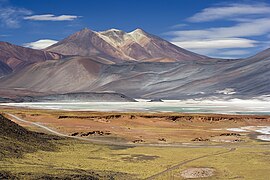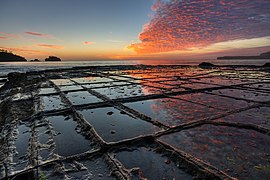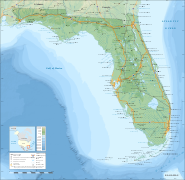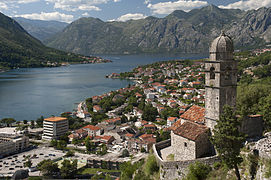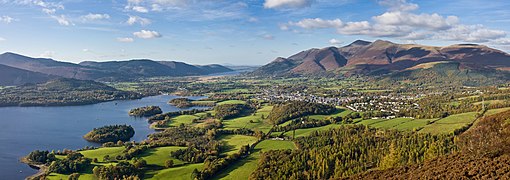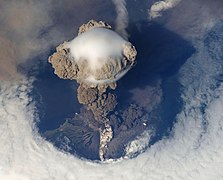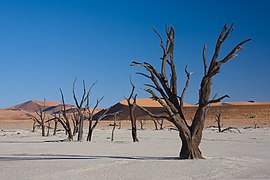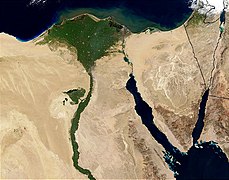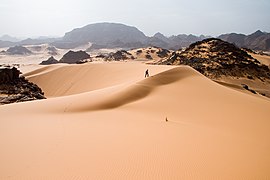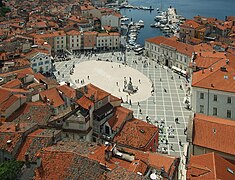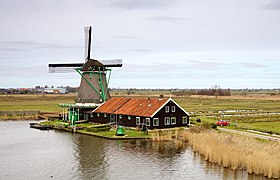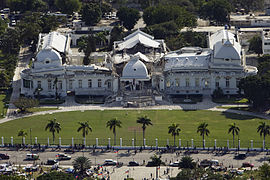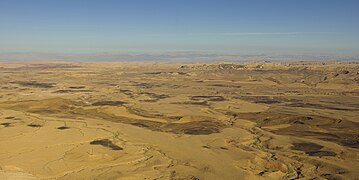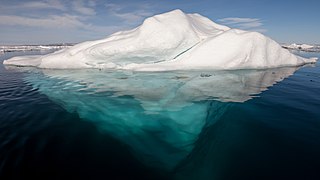Portal:Geography
The Geography Portal

Geography (from Ancient Greek γεωγραφία geōgraphía; combining gê 'Earth' and gráphō 'write') is the study of the lands, features, inhabitants, and phenomena of Earth. Geography is an all-encompassing discipline that seeks an understanding of Earth and its human and natural complexities—not merely where objects are, but also how they have changed and come to be. While geography is specific to Earth, many concepts can be applied more broadly to other celestial bodies in the field of planetary science. Geography has been called "a bridge between natural science and social science disciplines."
Origins of many of the concepts in geography can be traced to Greek Eratosthenes of Cyrene, who may have coined the term "geographia" (c. 276 BC – c. 195/194 BC). The first recorded use of the word γεωγραφία was as the title of a book by Greek scholar Claudius Ptolemy (100 – 170 AD). This work created the so-called "Ptolemaic tradition" of geography, which included "Ptolemaic cartographic theory." However, the concepts of geography (such as cartography) date back to the earliest attempts to understand the world spatially, with the earliest example of an attempted world map dating to the 9th century BCE in ancient Babylon. The history of geography as a discipline spans cultures and millennia, being independently developed by multiple groups, and cross-pollinated by trade between these groups. The core concepts of geography consistent between all approaches are a focus on space, place, time, and scale.
Today, geography is an extremely broad discipline with multiple approaches and modalities. There have been multiple attempts to organize the discipline, including the four traditions of geography, and into branches. Techniques employed can generally be broken down into quantitative and qualitative approaches, with many studies taking mixed-methods approaches. Common techniques include cartography, remote sensing, interviews, and surveying. (Full article...)

Kigali (Kinyarwanda pronunciation: [ci.ɡɑ́.ɾi]) is the capital and largest city of Rwanda. It is near the nation's geographic centre in a region of rolling hills, with a series of valleys and ridges joined by steep slopes. As a primate city, Kigali is a relatively new city. It has been Rwanda's economic, cultural, and transport hub since it was founded as an administrative outpost in 1907, and became the capital of the country at independence in 1962, shifting focus away from Huye.
In an area controlled by the Kingdom of Rwanda from the 15th century, and then by the German Empire in the beginning of the 20th century, the city was founded in 1907 when Richard Kandt, the colonial resident, chose the site for his headquarters, citing its central location, views and security. Foreign merchants began to trade in the city during the German era, and Kandt opened some government-run schools for Tutsi Rwandan students. Belgium took control of Rwanda and Burundi during World War I, forming the mandate of Ruanda-Urundi. Kigali remained the seat of colonial administration for Rwanda but Ruanda-Urundi's capital was at Usumbura (now Bujumbura) in Burundi and Kigali remained a small city with a population of just 6,000 at the time of independence. (Full article...)
The Battle of Hochkirch took place on 14 October 1758, during the Third Silesian War (part of the Seven Years' War). After several weeks of maneuvering for position, an Austrian army of 80,000 commanded by Lieutenant Field Marshal Leopold Josef Graf Daun surprised the Prussian army of 30,000–36,000 commanded by Frederick the Great. The Austrian army overwhelmed the Prussians and forced a general retreat. The battle took place in and around the village of Hochkirch, 9 kilometers (6 mi) east of Bautzen, Saxony.
Historians generally consider the battle as among Frederick's greatest blunders. Contrary to the advice of his subordinates, he refused to believe that the typically cautious Austrian commander Leopold von Daun would bring his troops into battle. The Austrian force ambushed his army in a pre-dawn attack. Over 30% of Frederick's army was defeated; five generals were killed, and he lost his artillery park and a vast quantity of supplies. Although Daun had scored a complete surprise, his attempt to pursue the retreating Prussians was unsuccessful. The escaped force united with another corps in the vicinity and regained momentum over the winter. (Full article...)

Aeneas Lionel Acton Mackintosh (1 July 1879 – 8 May 1916) was a British Merchant Navy officer and Antarctic explorer who commanded the Ross Sea party as part of Sir Ernest Shackleton's Imperial Trans-Antarctic Expedition, 1914–1917. The Ross Sea party's mission was to support Shackleton's proposed transcontinental march by laying supply depots along the latter stages of the march's intended route. In the face of persistent setbacks and practical difficulties, Mackintosh's party fulfilled its task, although he and two others died in the course of their duties. Mackintosh's first Antarctic experience was as second officer on Shackleton's Nimrod expedition, 1907–1909. Shortly after his arrival in the Antarctic, a shipboard accident destroyed his right eye, and he was sent back to New Zealand. He returned in 1909 to participate in the later stages of the expedition; his will and determination in adversity impressed Shackleton, and led to his Ross Sea party appointment in 1914.
Having brought his party to the Antarctic, Mackintosh was faced with numerous difficulties. Confused and vague orders meant he was uncertain of the timing of Shackleton's proposed march. His problems were compounded when the party's ship, SY Aurora, was swept from its winter moorings during a gale and was unable to return, causing the loss of vital equipment and supplies. In carrying out the party's depot-laying task, one man died; Mackintosh barely survived, owing his life to the actions of his comrades who brought him to safety. Restored to health, he and a companion disappeared while attempting to return to the expedition's base camp by crossing the unstable sea ice. Mackintosh's competence and leadership skills have been questioned by polar historians. Shackleton commended the work of the party, and equated the sacrifice of their lives to those given in the trenches of the First World War, but was critical of Mackintosh's organising skills. Years later, Shackleton's son, Lord Shackleton, identified Mackintosh as one of the expedition's heroes, alongside Ernest Joyce and Dick Richards. (Full article...)
Barry Voight (/vɔɪt/; born 1937) is an American geologist, volcanologist, author, and engineer. After earning his Ph.D. at Columbia University, Voight worked as a professor of geology at several universities, including Pennsylvania State University, where he taught from 1964 until his retirement in 2005. He remains an emeritus professor there and still conducts research, focusing on rock mechanics, plate tectonics, disaster prevention, and geotechnical engineering.
In April 1980, Voight's publications on landslides, avalanches, and other mass movements attracted the attention of Rocky Crandell of the United States Geological Survey (USGS), who asked him to look at a growing bulge on the Mount St. Helens volcano in the state of Washington. Voight foresaw the collapse of the mountain's north flank as well as a powerful eruption. His predictions came true when St. Helens erupted in May 1980; Voight was then hired by the USGS to investigate the debris avalanche that initiated the eruption. After his work at Mount St. Helens brought him international recognition, Voight continued researching and guiding monitoring efforts at several active volcanoes throughout his career, including Nevado del Ruiz in Colombia, Mount Merapi in Indonesia, and Soufrière Hills, a volcano on the Caribbean island of Montserrat. For his research, publications, and disaster prevention work as a volcanologist and engineer, Voight has been honored with numerous awards, appointments, and medals. (Full article...)
Enceladus is the sixth-largest moon of Saturn and the 18th-largest in the Solar System. It is about 500 kilometers (310 miles) in diameter, about a tenth of that of Saturn's largest moon, Titan. It is mostly covered by fresh, clean ice, making it one of the most reflective bodies of the Solar System. Consequently, its surface temperature at noon reaches only −198 °C (75.1 K; −324.4 °F), far colder than a light-absorbing body would be. Despite its small size, Enceladus has a wide variety of surface features, ranging from old, heavily cratered regions to young, tectonically deformed terrain.
Enceladus was discovered on August 28, 1789, by William Herschel, but little was known about it until the two Voyager spacecrafts, Voyager 1 and Voyager 2, flew by Saturn in 1980 and 1981. In 2005, the spacecraft Cassini started multiple close flybys of Enceladus, revealing its surface and environment in greater detail. In particular, Cassini discovered water-rich plumes venting from the south polar region. Cryovolcanoes near the south pole shoot geyser-like jets of water vapor, molecular hydrogen, other volatiles, and solid material, including sodium chloride crystals and ice particles, into space, totaling about 200 kilograms (440 pounds) per second. More than 100 geysers have been identified. Some of the water vapor falls back as "snow"; the rest escapes and supplies most of the material making up Saturn's E ring. According to NASA scientists, the plumes are similar in composition to comets. In 2014, NASA reported that Cassini had found evidence for a large south polar subsurface ocean of liquid water with a thickness of around 10 km (6 mi). The existence of Enceladus' subsurface ocean has since been mathematically modelled and replicated. (Full article...)
The River Parrett flows through the counties of Dorset and Somerset in South West England, from its source in the Thorney Mills springs in the hills around Chedington in Dorset. Flowing northwest through Somerset and the Somerset Levels to its mouth at Burnham-on-Sea, into the Bridgwater Bay nature reserve on the Bristol Channel, the Parrett and its tributaries drain an area of 660 square miles (1,700 km) – about 50 per cent of Somerset's land area, with a population of 300,000.
The Parrett's main tributaries include the Rivers Tone, Isle, and Yeo, and the River Cary via the King's Sedgemoor Drain. The 37-mile (60 km) long river is tidal for 19 miles (31 km) up to Oath. Between Langport and Bridgwater, the river falls only 1 foot per mile (0.2 m/km), so it is prone to frequent flooding in winter and during high tides. Many approaches have been tried since at least the medieval period to reduce the incidence and effect of floods and to drain the surrounding fields. (Full article...)
The Third Silesian War (German: Dritter Schlesischer Krieg) was a war between Prussia and Austria (together with its allies) that lasted from 1756 to 1763 and confirmed Prussia's control of the region of Silesia (now in south-western Poland). The war was fought mainly in Silesia, Bohemia and Upper Saxony and formed one theatre of the Seven Years' War. It was the last of three Silesian Wars fought between Frederick the Great's Prussia and Maria Theresa's Austria in the mid-18th century, all three of which ended in Prussian control of Silesia.
This conflict can be viewed as a continuation of the First and Second Silesian Wars of the previous decade. After the Treaty of Aix-la-Chapelle ended the War of the Austrian Succession, Austria enacted broad reforms and upended its traditional diplomatic policy to prepare for renewed war with Prussia. As with the previous Silesian Wars, no particular triggering event initiated the conflict; rather, Prussia struck opportunistically to disrupt its enemies' plans. The war's cost in blood and treasure was high on both sides, and it ended inconclusively when neither of the main belligerents could sustain the conflict any longer. (Full article...)
Because of the high risk of extinction for island fauna and the decline in coral reef ecosystems, Seacology's primary focus is projects in which villagers sign contracts under which they agree to help protect either terrestrial or marine habitat for a specified time in return for new buildings or services. The operations are low-cost, averaging around US$20,000 to $25,000. Construction is done with local labor and sometimes without the use of machinery. Seacology selects its projects by reviewing the recommendations of its field representatives and its scientific advisory board. (Full article...)

The Australasian Antarctic Expedition was a 1911–1914 expedition headed by Douglas Mawson that explored the largely uncharted Antarctic coast due south of Australia. Mawson had been inspired to lead his own venture by his experiences on Ernest Shackleton's Nimrod expedition in 1907–1909. During its time in Antarctica, the expedition's sledging parties covered around 4,180 kilometres (2,600 mi) of unexplored territory, while its ship, SY Aurora, navigated 2,900 kilometres (1,800 mi) of unmapped coastline. Scientific activities included meteorological measurements, magnetic observations, an expansive oceanographic program, and the collection of many biological and geological samples, including the discovery of the first meteorite found in Antarctica. The expedition was the first to establish and maintain wireless contact between Antarctica and Australia. Another planned innovation – the use of an aircraft – was thwarted by an accident before the expedition sailed. The plane's fuselage was adapted to form a motorised sledge or "air-tractor", but it proved to be of very limited usefulness.
The expedition was organised into three bases: one on the sub-Antarctic Macquarie Island and two on the Antarctic mainland. The main base, under Mawson's command, was set up at Cape Denison, about 500 kilometres (300 mi) west of Cape Adare, and a western base under Frank Wild was established on the Shackleton Ice Shelf, more than 2,400 kilometres (1,500 mi) west of Cape Denison. Activities at both mainland bases were hampered by extreme winds, which often made outside work impossible. (Full article...)
The Turabay dynasty (Arabic: آل طرباي, romanized: Āl Ṭurabāy) was a family of Bedouin emirs in northern Palestine who served as the multazims (tax farmers) and sanjak-beys (district governors) of Lajjun Sanjak during Ottoman rule in the 16th–17th centuries. The sanjak (district) spanned the towns of Lajjun, Jenin and Haifa, and the surrounding countryside. The progenitors of the family had served as chiefs of Marj ibn Amir (the Plain of Esdraelon or Jezreel Valley) under the Egypt-based Mamluks in the late 15th century.
During the conquest of the Levant and Egypt by the Ottoman Empire in 1516–1517, the Turabay chief Qaraja and his son Turabay aided the forces of Ottoman Sultan Selim I. The Ottomans kept them in their Mamluk-era role as guardians of the strategic Via Maris and Damascus–Jerusalem highways and rewarded them with tax farms in northern Palestine. Their territory became a sanjak in 1559 and Turabay's son Ali became its first governor. His brother Assaf was appointed in 1573, serving for ten years before being dismissed and exiled to Rhodes for involvement in a rebellion. His nephew Turabay was appointed in 1589 and remained in office until his death in 1601. His son and successor Ahmad, the most prominent chief of the dynasty, ruled Lajjun for nearly a half-century and repulsed attempts by the powerful Druze chief and Ottoman governor of Sidon-Beirut and Safed, Fakhr al-Din Ma'n, to take over Lajjun and Nablus in the 1620s. He consolidated the family's alliance with the Ridwan and Farrukh governing dynasties of Gaza and Nablus, which remained intact until the dynasties' demise toward the end of the century. (Full article...)























